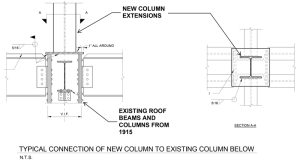The Mid-Manhattan Library Expansion
The New York Public Library (NYPL) system has served New York City since 1895, providing, as noted on its website, “free books, information, ideas, and education for all New Yorkers.” While many people may picture the grand marble façade and imposing lions of the Stephen A. Schwarzman Building (SASB) at Bryant Park (famously featured in Ghostbusters, among other movies and pop culture), SASB has been solely a research library since 1970. In that year, the circulating division of the branch, the part of the library that allows checking out books and materials, moved across the street to the upper floors of the Arnold Constable & Co. department store. This new branch was named the Mid-Manhattan Library.
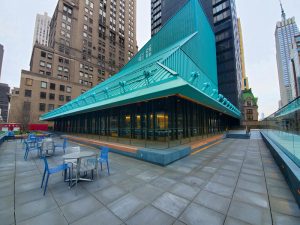
The Mid-Manhattan Library quickly became the busiest circulating library in the NYPL system and took over the entire Arnold Constable building in 1980, undergoing a complete building renovation in 1982. The building sat, aging and unchanged, for the next 30+ years until a new renovation was announced in 2016. The gut renovation of the 6-story steel-framed, cinder-slab building aimed to maintain the existing capacity for approximately 400,000 books while increasing space for occupants and community learning programs, adding new business, children, and teen libraries, and fully modernizing the MEP and IT systems. To achieve these goals, the architects, Mecanoo and BBB, proposed a new 3-story rooftop addition, the creation of the long room stacks by inserting new mezzanine levels between existing floor plates, and improved circulation throughout the building.
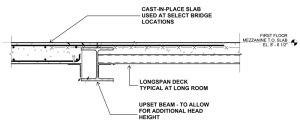
The existing structure was built in 1915 and was constructed of concrete and terracotta-encased steel framing with draped mesh cinder slabs. Though there was no distinct lateral system, all beam-to-column connections had wind clips providing moderate frame action at all bays, as was typical of the time of construction. The building was founded on shallow foundations with multiple levels of steel grillage beams encased in concrete. Reviewing original building information and evaluating existing column and footing sizes determined that the original structure was likely built with an intention to add multiple levels in the future. This overdesign allowed for the insertion of additional long room floors and a new 3-story addition without any existing column or foundation reinforcing.
In a creative use of space by the architects, the existing 3rd and 4th floor framing along the eastern-most end of the building was removed and replaced with 4 mezzanine levels to create the long room, a modern interpretation of the stacks found in older libraries. This move allowed for additional high-density book storage while creating an ample atrium space connecting levels 2, 3, and 4 and showing off a large portion of the library’s vast collection of books. However, to squeeze four floors where there had previously been two, the architects needed a thin, beam-free structure for the long room. The span of the long room varied from 19 feet to 22.5 feet and needed to support a library stack live load of 150 psf. In keeping with the theme, a long-span metal deck was chosen, specifically a 3.5-inch-deep acoustic deck with 4.5 inches of normal weight concrete topping for a total floor sandwich 8 inches deep.
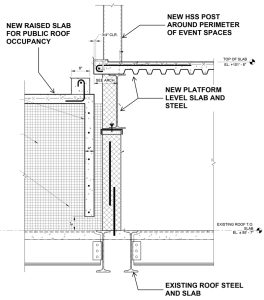
As the live loading and deck span pushed the deck to its limits, a full composite analysis of the deck was conducted to verify the floor’s strength and serviceability performance. As a result, 6,000 psi concrete was required, and longitudinal rebar was added to achieve the longer span conditions and allow for required MEP openings in the deck. Shoring and sequencing the demolition in this area to install the new deck was also crucial, as floor removals temporarily unbraced existing double-height columns. The new long-span deck also required shoring until the concrete had set and was able to re-brace the columns.
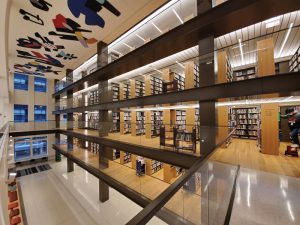
With the limited amount of space in the existing building, the only direction to go for more square footage was up! A 3-story rooftop addition was proposed to provide three large multipurpose spaces, a café, an outdoor public space, and a new space for major mechanical and electrical equipment. Mecanoo developed a unique massing scheme for the addition with sloped roofs, large, column-free public spaces, and efficient but crowded back-of-house and mechanical spaces.
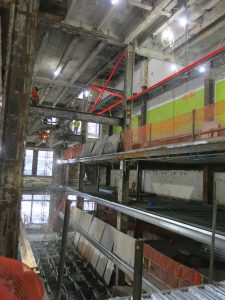
The original roof structure outside the new addition’s footprint was reused to support a new public occupancy roof and roof garden – this required welded reinforcing of the original riveted connections at many of the roof girders. The rooftop addition required extending many existing columns, which were arranged in a classic rectilinear grid, approximately 4 feet higher, to create a new platform level. This platform level provided the first floor of the new addition and a landing point for the proposed irregular column grid required for the additional new roof levels above. An array of HSS tube columns along the edge of the platform, mimicking and hidden behind new window mullions in the multipurpose rooms, supported the base of the sloping roof that made up the Wizard’s Hat addition. In contrast, a main zig-zagging column line and a large full-story truss supported the top and sides of the slope and the two mechanical levels of framing above. The lateral system of the addition, which per the New York City Building Code’s (NYCBC) unique approach to renovations was only required to be designed for wind loading, is a combination of braced frames at the south face of the addition and moment frames throughout the main occupiable areas.
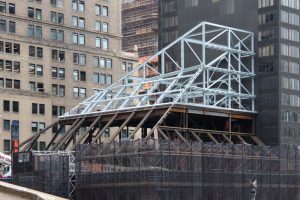
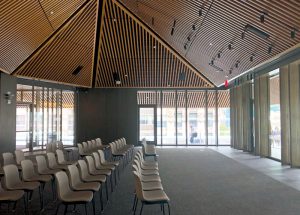
A name change came with the renovations, new addition, and new resources. Upon the building’s opening, the Mid-Manhattan Library, or MML to those who frequented it, became the Stavros Niarchos Foundation Library, or SNFL (“sniffle,” if you were wondering). The sad step-sibling of the more famous SASB main branch building, once referred to by one of its own as an “embarrassment” to the NYPL system, is now a modern, open, inviting, and unique building in its own right. It proudly boasts one of the few totally free public roofs in New York City, and the only one in midtown Manhattan, while continuing the long NYPL tradition of “free books, information, ideas, and education for all New Yorkers.”■
Project Team
Structural Engineer: Silman
Architects: Mecanoo and Beyer Blinder Belle
MEP Engineer: Kohler Ronan
Contractor: Tishman Construction Company/AECOM

